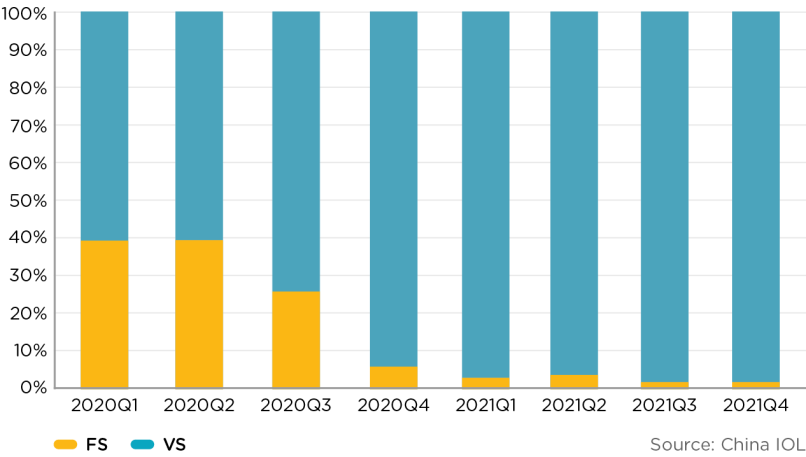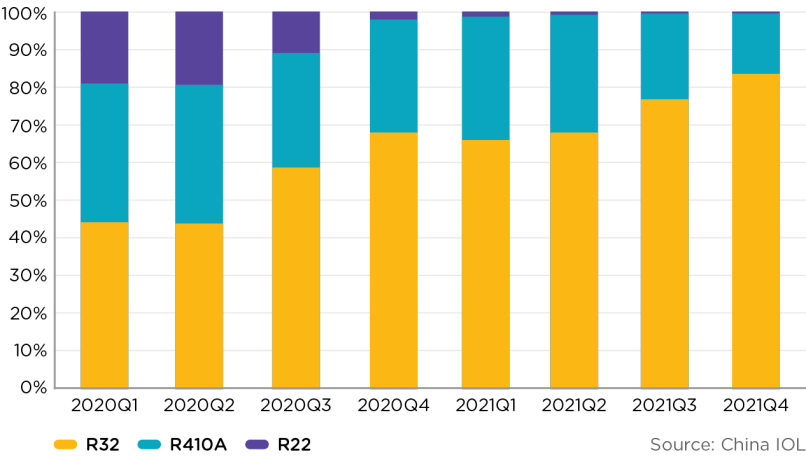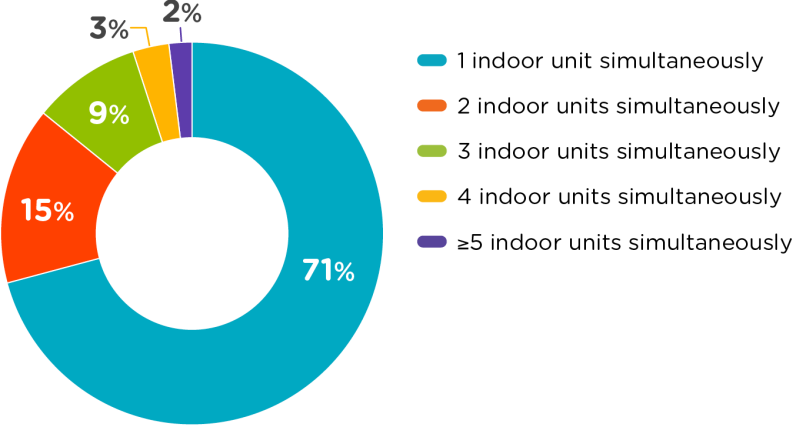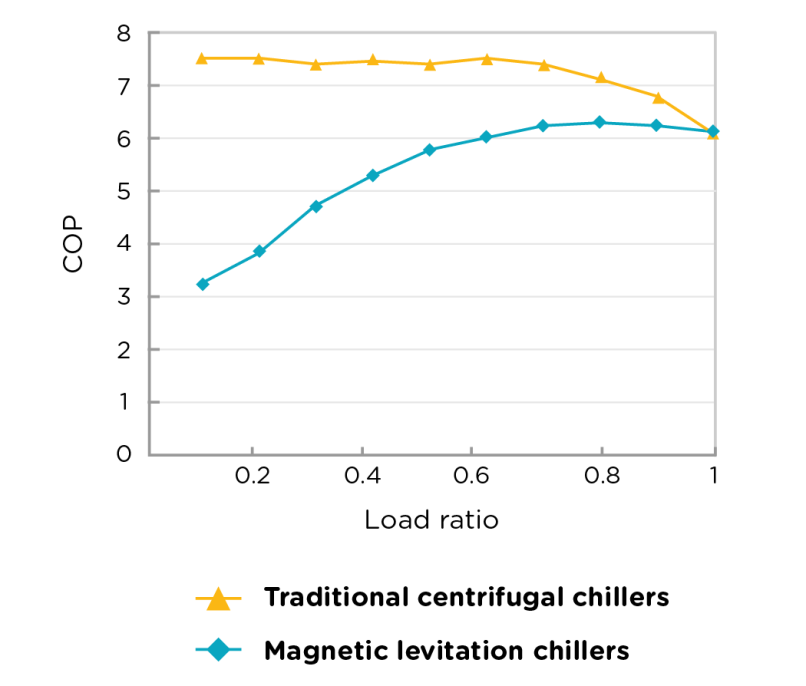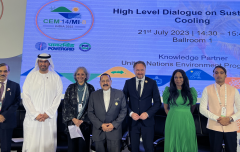Chilling Prospects 2022: China's progress towards sustainable cooling
|
Reflections on five years of the Kigali Amendment by the Building Energy Research Center of Tsinghua University, China |
China’s National Green Cooling Action Plan
In June 2019, China unveiled its first national Green Cooling Action Plan (GCAP), an integrated master plan with new energy efficiency and market penetration targets for air conditioners and other cooling products, driving improvements in cooling efficiency and the transition to green refrigerants. The plan was the result of an 18-month-long joint effort between key government agencies, including seven ministries, and was led by the National Development and Reform Commission (NDRC), in collaboration with research institutes, industry associations and civil society.
The GCAP sets clear targets for China's cooling sector. By 2030, the energy efficiency of major cooling products should increase by over 25 percent; the market share of green and efficient cooling products should increase by 40 percent; and the energy efficiency of large public buildings should increase by 30 percent compared to 2022 levels, achieving annual electricity savings of 400 billion kWh combined. Actions to achieve these targets include upgrading energy-efficiency standards for air-conditioning and refrigeration; increasing the supply of green cooling products; promoting cooling-efficiency retrofits; and deepening international cooperation. Following the launch of the GCAP, cooling retrofit projects were also included in the subsidy programme of China’s Special Fund for Ecological Civilization Construction.
Upgraded energy performance standards to accelerate market shift
After the launch of the GCAP, and in synergy with the implementation of the Kigali Amendment, China upgraded the minimum energy performance standards (MEPS) for room air conditioners (RACs) and multi-connected air-conditioning (heat pump) units with variable refrigerant flow (VRF), the two dominant air-conditioning products for the residential and commercial sectors.
The revised standard for RACs merged requirements for fixed- and variable-frequency air conditioners, which accelerated the market transition toward variable-speed air conditioners. Today, fixed-frequency air conditioners account for only 2 percent of the domestic market (Figure 1a). Positive trends were also seen in the use of refrigerants, with the market shifting quickly away from the use of R-22 and R-410a refrigerants, and R-32 technology dominating about 80 percent of total refrigerant sales in 2021 (Figure 1b).
Figure 1a: Domestic sales % of RAC by fixed/variable frequency ACs
Figure 1b: Domestic sales % of RAC by refrigerant type
In October 2021, the revision of MEPS for multi-connected air-conditioning units led to an overall energy-efficiency improvement of 40.5 percent compared to 2008 figures. The testing method was also upgraded with a more rigorous annual performance factor (APF). Overall, the revision is expected to generate over 278 billion kWh in energy savings by 2030.
Further opportunities for efficient technologies
Promoting better passive building design to reduce cooling demand
Passive building design takes optimal advantage of natural resources, including light, ventilation, shading and cooling, to create an optimum indoor environment and reduce energy demand. Well-designed natural ventilation systems save 13 to 44 kWh/m2 of cooling net energy per year. For instance, one office building in Shenzhen that has incorporated passive design has reduced the time that air-conditioning is in use by 40 percent compared with other local office buildings, while achieving the same level of indoor thermal comfort.
Meeting end users’ cooling demands with decentralized cooling systems
In the past two decades, surveys on the energy consumption of buildings found that among the main drivers of variation in buildings’ energy consumption are: i) the type of cooling system used; and ii) occupant behaviour patterns. Analysis showed that as much as 71 percent of the total operating time of VRF systems during one cooling season is characterized by only one unit in operation (Figure 2). In this context, centralized air-conditioning systems, provide full-time and full-space service regardless of the occupancy state of each room. Decentralized cooling systems, on the other hand, can provide a flexible, controllable part-time and part-space service, by switching off devices when the space is empty. Occupant energy usage patterns lead to further variation in energy consumption: while for most users energy consumption per unit area is below 30kWh/m2, the maximum usage can reach 89kWh/m2.
Figure 2: Distribution of the number of operating indoor units and energy consumption
Data source: Gree analysis in 2,776 residential VRF systems (2020)
Increasing energy efficiency of cooling systems
High-efficiency cooling systems require that: i) the rated coefficient of performance (COP) of cooling devices is as high as possible; and ii) the capacity of cooling devices is adequately combined so that they operate in the high-efficiency zone at different load levels. In this context, it is important to further develop cooling equipment that can operate with high efficiency even at partial load. For instance, magnetic levitation chillers can increase cooling energy efficiency over full range, especially on a low load ratio, compared to traditional centrifugal chillers (Figure 3).
Figure 3: COP of chillers under different load ratio
Source: Manufacturer's test results (Cooling water inlet 30℃, chilled water outlet 7℃)
A newly developed compressor technology for air conditioners shows significant potential to solve the efficiency problem at partial load. Combining a large- and a small-volume cylinder operating in parallel, this compressor greatly improves efficiency at load below 30 percent, even surpassing that of mono-split units.
New, ultra-efficient air conditioners also combine smart evaporative cooling ventilation with photovoltaic panels, which could reduce the climate impact of air-conditioning1 by more than 85 percent.
Replacing refrigerants with zero GWP cooling technology
Efforts to replace refrigerants in line with the Kigali Amendment currently tend to focus on deploying refrigerants with low global warming potential (GWP), zero ozone depletion potential (ODP) and high efficiency. Air conditioners are typically among the first categories of equipment that are targeted by policymakers in this area. However, solutions such as direct and indirect evaporative cooling technologies provide valid alternatives to mechanical air-conditioning, particularly for dry regions. Indirect evaporative cooling solutions consume electricity only for pumps and fan operation and do not use any refrigerant gas. Test data suggest that this solution could save up to 40 percent of energy use compared with traditional vapour compression air-conditioning systems.

